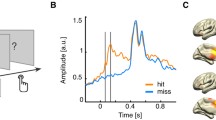Abstract
A key working hypothesis in neuroscience is ‘materialistic reductionism’, i.e., the assumption whereby all physiological, behavioral or cognitive phenomena is produced by localized neurochemical brain activation (but not vice versa). However, analysis of sub-threshold Weber’s psychophysical stimulation indicates its computational irreducibility to the direct interaction between psychophysical stimulation and any neuron/s. This is because the materialistic-reductionistic working hypothesis assumes that the determination of the existence or non-existence of any psychophysical stimulation [s] may only be determined through its direct interaction [di1] with a given neuron/s [N] that together forms the ‘neural registry’ computational level [NR/di1]. But, this implies that in cases of (initial) sub-threshold (sensory-specific) psychophysical stimulation which is increased above the sensory-specific threshold but below Weber’s psychophysical ‘dv’—the psychophysical computational processing [PCP] produces an apparently ‘computationally indeterminate’ output. This is because materialistic reductionism asserts the contingency of PCP upon the existence of a direct interaction between ‘s’ and ‘N’ within the NR/di1 level, but in the special case of Weber’s sub-threshold psychophysical stimulation the same PCP/di1 also asserts the non-existence of ‘s’ (as demanded by Weber’s psychophysical law). However, given robust empirical evidence indicating the capability of PCP to determine whether (or not) ‘s’ exists, we must conclude that PCP may not be carried out from within NR’s direct interaction between a particular psychophysical stimulation and any set of neuron/s in the brain. Hence, the Duality Principle asserts the conceptual irreducibility of sub-threshold psychophysical stimulation to any direct NR/di1: s-N interaction, thereby challenging the current materialistic-reductionistic assumption.
Similar content being viewed by others
References
Carreiras, M., Mechelli, A., & Price, C. J. (2006). Human brain mapping (in press).
Cavina-Pratesi C., Valyear K.F., Culham J.C., Kohler S., Obhi S.S., Marzi C.A., Goodale M.A. (2006). Journal of Neurscience, 26(10):2704–2713
Cedar S., Cifelli A., Abu-Omar Y., Palace J., Matthews P.M. (2006). Brain, 129(Pt 2):527–537
Chalmers D.J. (1995). Journal of Consciousness Studies, 2, 200–219
PeinemannA., Schuller S., Pohl C., Jahn T., Weindl A., Kassubek J. (2005). Journal of the Neurological Sciences, 239(1):11–19
Rauschecker J.P. (2005). Annals of the New york Academy of Sciences, 1060, 125–135
Tregellas, J. R., Davalos, D. B., & Rojas D. C. (2006). NeuroImage (in press).
Author information
Authors and Affiliations
Corresponding author
Rights and permissions
About this article
Cite this article
Bentwich, J. The duality principle: irreducibility of sub-threshold psychophysical computation to neuronal brain activation. Synthese 153, 451–455 (2006). https://doi.org/10.1007/s11229-006-9101-5
Received:
Accepted:
Published:
Issue Date:
DOI: https://doi.org/10.1007/s11229-006-9101-5




